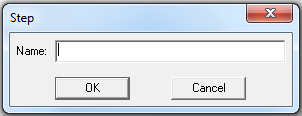Step

This function block realizes a working step of a sequence control.
The function block has the input SI, the output SO and the output SM. SI has to be connected with a transition. Over this transition the token will be transferred to this block. SO has to be connected with a transition. Over this transition the token will be transferred. The output SM is a BIT data type. It shows if this block has a token or not.
At runtime any Step block can get a token from another Step block by passing the intermediate transition. If the block holds a token, it is active. The block loses the token if a followed transition allows the passing. Then the step is inactive again.
For general information about sequence function and its realization see introduction.
Parameters

The parameter dialog can be used to assign a name to the function block. The text will be depicted in the symbol.
Signals
| Name | I/O | Type(s) | Function |
|---|---|---|---|
| SI | I | TOSTEP | Sequence input |
| SO | O | TOTRANS | Sequence output |
| SM | O | BIT | State (token) |
Visualization
If the step is currently active, the symbol will be depicted in green. If the function block is connected in a way, which is potentially harmful for the control flow (e.g. aggregation of tokens), it will be depicted in yellow.
Comment
All sequences contained in a macro or program block belong to a structure net. A sequence net may also span more than one macro or program block, if special sequence connections exist between the single blocks.
